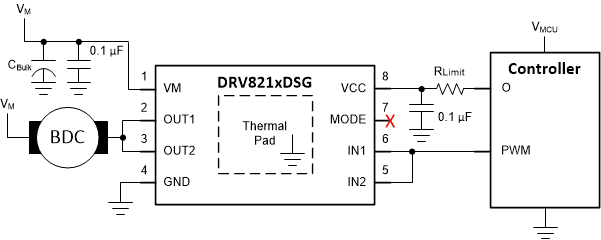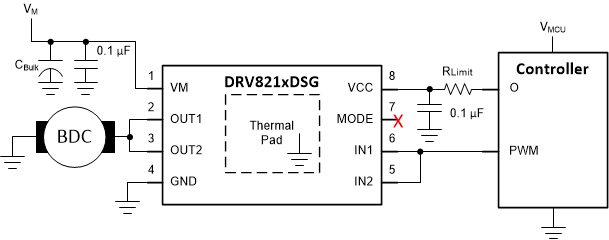SLVSFY8B February 2020 – August 2021 DRV8210
PRODUCTION DATA
- 1 Features
- 2 Applications
- 3 Description
- 4 Revision History
- 5 Device Comparison
- 6 Pin Configuration and Functions
- 7 Specifications
- 8 Detailed Description
- 9 Application and Implementation
- 10Power Supply Recommendations
- 11Layout
- 12Device and Documentation Support
- 13Mechanical, Packaging, and Orderable Information
Package Options
Mechanical Data (Package|Pins)
Thermal pad, mechanical data (Package|Pins)
- DSG|8
Orderable Information
9.2.2 Half-Bridge Driving
The DRV8210 can be configured to half-bridge mode by leaving the MODE pin floating. In this mode, the device outputs can be used as low-side or high-side drivers. This allows the device to drive various loads such as one or two motors unidirectionally (only in one direction), solenoids, valves, and relays. Figure 9-9 shows the device used as a low-side driver on OUT1 and high-side driver on OUT2. Both loads may also be driven from the high-side or from the low-side. By tying the INx pins together and OUTx pins together, as shown in Figure 9-10 and Figure 9-11, the device can drive a single load with half of the RDS(on). This can accommodate larger current requirements. This configuration is called "parallel half-bridge mode."
In half-bridge mode, the other FETs and body diodes in the half-bridge will recirculate freewheeling current during the off-time of the PWM duty cycle, so extra external diodes are not needed.
 Figure 9-11 Half-bridge mode used as a low-side driver with
outputs paralleled
Figure 9-11 Half-bridge mode used as a low-side driver with
outputs paralleled Figure 9-10 Half-bridge mode used as a high-side driver with
outputs paralleled
Figure 9-10 Half-bridge mode used as a high-side driver with
outputs paralleled